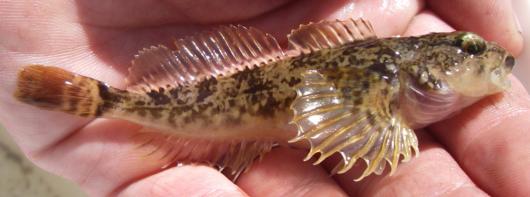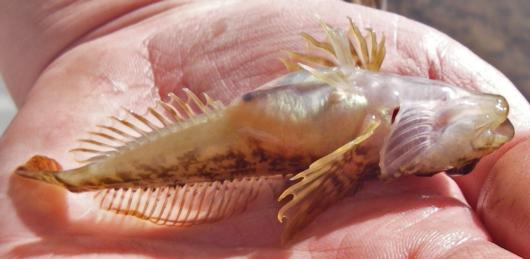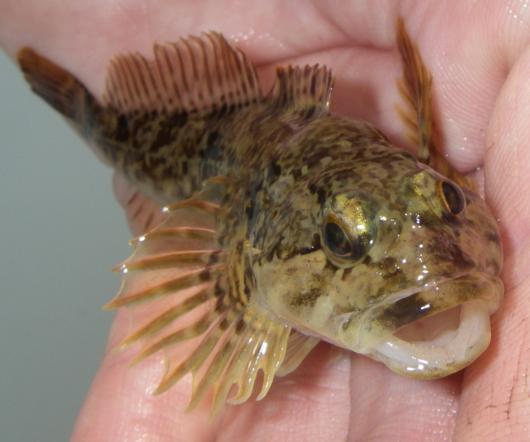Riffle Sculpin
-
Scientific NameCottus gulosus
-
NativeYes
-
Identification
 Riffle sculpin, side view. Location: South Fork American River. Date: 5 May 2010. Photo by Lisa C. Thompson.
Riffle sculpin, side view. Location: South Fork American River. Date: 5 May 2010. Photo by Lisa C. Thompson. Riffle sculpin, ventral view. Location: South Fork American River. Date: 5 May 2010. Photo by Lisa C. Thompson.
Riffle sculpin, ventral view. Location: South Fork American River. Date: 5 May 2010. Photo by Lisa C. Thompson. Riffle sculpin, frontal view. Location: South Fork American River. Date: 5 May 2010. Photo by Lisa C. Thompson.
Riffle sculpin, frontal view. Location: South Fork American River. Date: 5 May 2010. Photo by Lisa C. Thompson.- Adults up to 100 mm SL, larger sizes rare
- Large mouth, maxillary may reach rear margin of eye
- Prickles behind pectoral fins
- Pre-opercular spines: 2-3
- One median chin pore
- Joined dorsal fins (usually)
- Mottled coloration, black spot on rear side of 1st dorsal fin
- Spawning males dark, may have orange edge of 1st dorsal
- Fin spines/rays: pelvic 1 spine/3-4 rays, 1st dorsal 7-8 spines, 2nd dorsal 16-19 rays, pectoral 15-16 rays, anal 12-16 rays
- Pelvic fin "elements": 4 (1 spine, 3-4 rays, but the spine may be fused with the 1st ray)
- Lateral line: complete or incomplete, 22-36 pores
-
Life History
Riffle Sculpins are found in headwater streams with cold water and rocky or gravelly substrate. They prefer permanent streams where the water does not exceed 25-26°C, and where ample flow keeps the dissolved oxygen level near saturation. Riffle Sculpins may occupy riffles or pools, though they tend to favor areas that have adequate cover in the form of rocks, logs, or overhanging banks. These fish have similar habitat requirements similar to those of rainbow trout and are often found in association with them. Riffle Sculpins are opportunistic feeders that may pursue prey by night or ambush during the day. The diet of a sculpin may include amphipods, benthic invertebrates, fish, and various stages of caddisflies and mayflies. Riffle Sculpins reach sexual maturity in the end of their second year, with spawning taking place in late winter to early spring. Females lay 462-1,000 or more eggs under rocks within swiftwater reaches of a stream. The male takes the responsibility of guarding the nest which may contain the eggs of multiple females. Riffle Sculpins rarely exceed 4 years of life.
-
Links to Other ResearchN / A


